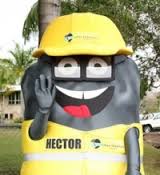
From Reuters, China is suddenly imposing import tariffs on both coals:
“China is clearly moving to protect its local miners. Given that the tariff also covers coking coal, Australia, being the top supplier to China, is likely going to be the most affected,” said Serene Lim, an analyst at Standard Chartered.
The Ministry of Finance said in a statement on Thursday that import tariffs for anthracite coal and coking coal will return to 3 percent, while non-coking coal will have an import tax of 6 percent. Briquettes, a fuel manufactured from coal, and other coal-based fuels will see their import tariffs return to 5 percent.
Import taxes for all coals, with the exception of coking coal, was at 6 percent prior to 2005 before they were scrapped in 2007. Coking coal import taxes were set at 3 percent before being abolished in 2005.
News of the tariff lifted China’s thermal coal futures by 1.9 percent to 529.2 yuan ($86.33) a tonne, while China-listed shares in top miners such as Shenhua Energy and China Coal Energy also rose.
Chinese traders were only willing to pay about $65 a tonne for coal with heating value of 5,500 kcal/kg (NAR) on a landed basis before the tariff was announced, against offers of about $66 a tonne by Australians, traders said.
“With the latest tax, Chinese can only offer around $62, which means Australian sellers will need to cut prices by about $3.50-$4 a tonne,” said a senior trader at major international trading house.
“It is game over for Australian coal.”
Guess what will happen to iron ore when the price pressures become too great? At the AFR, the usual interests are squawking:
The crucial final stages of free trade talks between Canberra and Beijing have been thrown into turmoil following China’s shock decision to impose harsh new tariffs on Australian coal supplies.
…The news brought an angry reaction from the federal opposition and the Australian mining sector.
The Minerals Council of Australia’s (MCA) Brendan Pearson said the decision was a poor one.
“The MCA urges the Australian government to initiate urgent discussions with Chinese counterparts to seek the reversal of the decision,” he said in a statement.
He said applying tariffs would ultimately prove “counterproductive” for the struggling Chinese economy anyway because it would “raise energy costs for China’s industrial sector and households”.
“This decision raises the stakes on the outcome of talks on a free trade agreement with China due to conclude next month,” he said.
Trade Minister Andrew Robb said he was seeking full clarity via our post in China but stressed that there would always be a strong place in the market for Australian high-grade, lower emission coal.
“This highlights the importance of concluding high quality Free Trade Agreements to shore-up our competitive position,” he said.
Indonesia is excluded from the tariffs owing to its China FTA. Perhaps it would be better to look to the future? From Thinkprogress:
Australia’s investment in clean energy projects has slumped 70 percent since 2013, according to a new report by Bloomberg New Energy Finance (BNEF). This means the country has slipped from the world’s 11th largest investor in clean energy to the 31st — below Algeria, Myanmar, Thailand, and Uruguay. This is the latest result of Liberal Prime Minister Tony Abbott’s broad attack on the country’s previously ambitious clean energy and climate goals. Abbott came into power in September 2013 and in July, Australia became the first country to repeal its carbon price, despite the fact that it was successfully working to cut carbon emissions.
Kobad Bhavnagri, an analyst at BNEF, told the Guardian Australia that the country’s renewable energy sector is “in the doldrums” and that “the government’s position has caused this.”
Australia’s government “has had some pretty strong anti-renewables rhetoric, particularly anti-wind, and wants to close certain clean energy programs,” Bhavnagri said. “The review has been particularly protracted. The industry was fearful the recommendations would be extreme and they were. It has been shattering.”
Bhavnagri is referring to the government’s review of the country’s Renewable Energy Target, which mandates that 41,000 gigawatt hours of Australia’s energy comes from renewable sources by 2020. The government has said it will review, and possibly scrap, the target in the coming months.
Under Abbott’s lead, just $193 million was invested in new large-scale clean energy projects in the third quarter of 2014, according to BNEF, bringing year-to-date investment to $238 million. By comparison, Canada has invested $3.1 billion in large clean energy projects so far this year.
Nah. Sell ’em dirt!

